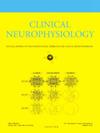Aerobic exercise acutely increases EEG gamma power in the motor/sensorimotor areas during walking in people with Parkinson’s disease
IF 3.7
3区 医学
Q1 CLINICAL NEUROLOGY
引用次数: 0
Abstract
Objective
This study investigated the effects of acute aerobic exercise on gait function and cortical activity during single and dual-task walking in people with Parkinson’s disease (PwPD).
Methods
Thirty PwPD were randomly assigned to the Experimental (EG) and Control Group (CG). Both groups completed a single 40-minute session of cycling. Exercise intensity was maintained at 65–70% of the maximum heart rate for EG and within 5% of the resting heart rate for CG. Participants performed five walking trials under each condition before and after exercise. EEG and accelerometers measured cortical activity and gait parameters.
Results
In the post- vs. pre-exercise, the EG increased gamma power in the C and CP channels during single and dual-task walking. Increased step length during dual-task condition was positively associated with increased gamma power at the C and CP channels.
Conclusion
Acute exercise enhances movement control and sensorimotor integration during walking, evidenced by increased gamma power. Changes in gamma power in the motor/sensorimotor areas may improve step length during dual-task walking.
Significance
This study underscores the potential of aerobic exercise to increase the involvement of motor and sensorimotor cortical regions, highlighting the relevance of aerobic exercise in the neurorehabilitation and gait functions in PwPD.
有氧运动急剧增加帕金森病患者行走时运动/感觉运动区的脑电图伽马功率
目的研究急性有氧运动对帕金森病(PwPD)患者单任务和双任务行走时步态功能和皮质活动的影响。方法将30只PwPD随机分为实验组(EG)和对照组(CG)。两组人都完成了一次40分钟的骑行。运动强度维持在EG最大心率的65-70%,CG静止心率的5%以内。参与者在运动前后分别进行了五次步行试验。脑电图和加速度计测量皮质活动和步态参数。结果运动后与运动前相比,eeg增加了单任务行走和双任务行走时C通道和CP通道的伽马能量。双任务条件下步长增加与C和CP通道伽马功率增加呈正相关。结论急性运动增强了步行时的运动控制和感觉运动整合,表现为伽马能量的增加。运动/感觉运动区域伽马能量的变化可能会改善双任务行走时的步长。这项研究强调了有氧运动增加运动和感觉运动皮质区域参与的潜力,强调了有氧运动在PwPD的神经康复和步态功能中的相关性。
本文章由计算机程序翻译,如有差异,请以英文原文为准。
求助全文
约1分钟内获得全文
求助全文
来源期刊

Clinical Neurophysiology
医学-临床神经学
CiteScore
8.70
自引率
6.40%
发文量
932
审稿时长
59 days
期刊介绍:
As of January 1999, The journal Electroencephalography and Clinical Neurophysiology, and its two sections Electromyography and Motor Control and Evoked Potentials have amalgamated to become this journal - Clinical Neurophysiology.
Clinical Neurophysiology is the official journal of the International Federation of Clinical Neurophysiology, the Brazilian Society of Clinical Neurophysiology, the Czech Society of Clinical Neurophysiology, the Italian Clinical Neurophysiology Society and the International Society of Intraoperative Neurophysiology.The journal is dedicated to fostering research and disseminating information on all aspects of both normal and abnormal functioning of the nervous system. The key aim of the publication is to disseminate scholarly reports on the pathophysiology underlying diseases of the central and peripheral nervous system of human patients. Clinical trials that use neurophysiological measures to document change are encouraged, as are manuscripts reporting data on integrated neuroimaging of central nervous function including, but not limited to, functional MRI, MEG, EEG, PET and other neuroimaging modalities.
 求助内容:
求助内容: 应助结果提醒方式:
应助结果提醒方式:


